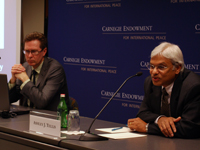Registration
You will receive an email confirming your registration.
IMGXYZ3216IMGZYXStrategic mistrust between China and India has worsened in recent years, prompting concerns that the world’s two most populous states are doomed to rivalry as their power and interests expand. But Beijing’s immediate security anxieties lie elsewhere, and its present relationship with New Delhi might be described as one of competitive coexistence.
Rory Medcalf of Australia’s Lowy Institute identified the key indicators of security competition between Asia’s rising giants and discussed whether rivalry is inevitable. Carnegie’s Ashley J. Tellis moderated.
A Complicated Relationship
Tellis began by noting that the Sino-Indian relationship is a very complicated one, and that it cannot be captured by either the idea of competition or cooperation alone. Both states face significant constraints on their behavior, including economic ties, domestic imperatives, and the presence of other great powers. Tellis added that any competition or rivalry that arises between them will be embedded in these constraining relationships.
The Past and Present: Background and Trends
Medcalf cautioned that not all competition rises to the level of rivalry, and that true rivalry covers many dimensions—economic, military, diplomatic, and soft power. Rivalry cannot be one-sided, and core interests must be at stake in such a way that a state would be willing to risk war to protect them. Medcalf then analyzed the historical and contemporary status of China and India’s rivalry:
- Economic: Medcalf noted that both states are economically engaged with each other. China is India’s largest trading partner, and the two nations are on track to become two of the world’s three largest economies. However, the trade balance is in China’s favor, and India does not play a particularly significant role in China’s economic growth.
- Military: There is considerable mistrust in China-Indian military relations, Medcalf said, stemming from India’s 1962 military defeat at China’s hands. Events shortly afterward, including China’s nuclear testing and its establishment of ties with Pakistan, led to a tense relationship between the two countries in the 1960s and 1970s. Since then, some mistrust has abated, and confidence building measures have been instituted, although it is unclear how much of a difference they have made. There has been a slow evolution of military talks, he added.
- Diplomatic: Cooperation between the two nations exists, but it is sporadic, event-specific, and based on common, short-term interests. There is no real, abiding diplomatic relationship, said Medcalf.
- Soft Power: Thus far, little competition seems to exist in the soft-power sphere, according to Medcalf, as India has not actively sought soft-power projection in the way that China has.
Competitive Dynamics
Medcalf argued that a variety of factors contribute to a competitive dynamic between the countries, one that might lead to more rivalry in the future:
- Commonalities Leading to Competition: Medcalf argued that commonalities—such as the need for energy, water, and internal stability—may lead to cooperation between China and India, but they may also contribute to tensions fueled by nationalism, the media, and institutional imperatives.
- Irritants in the Relationship: Medcalf added that a variety of other issues—including border disputes, the maritime commons, Tibet and the Dalai Lama, regional forums, and soft-power competition in East and South Asia—may worsen the bilateral relationship over time.
- The Uneven Trade Balance: India is increasingly concerned about its uneven trade balance with China. As India’s economy moves more and more into the manufacturing sector, economic relations between the two countries may become more competitive.
- Soft-Power Competition: Although India has not traditionally attempted soft-power projection, it is increasingly doing so and competing with China in using aid to influence perceptions. To some extent, competition in this sphere is not just between China and India, but also against many other players. Additionally, Medcalf noted that China and India’s success on this front will largely be determined by domestic factors, as the 2008 Beijing Olympics and the 2010 Commonwealth Games showed.
The Future
- The U.S.-India Relationship: The U.S.-India relationship experienced a breakthrough under President George W. Bush in 2005 but, since then, the Sino-Indian relationship has deteriorated. India is wary of China, but it is also wary of strategic alignment with the United States, and it will continue to engage both countries and hedge its strategic bets as long as it can. Ultimately, Medcalf argued, the United States offers a strategic partnership while China offers only threats.
- The Sino-Pakistani Relationship: The Sino-Pakistani relationship remains a major irritant for India, and any true Sino-Indian relationship is unlikely until China consciously places India’s interests before Pakistan’s, which is unlikely to happen anytime soon.
- Other Extant Issues: Medcalf added that other issues, including nuclear stability and the maritime commons, would become increasingly central to the competitive dynamic between the two countries.
Medcalf stated that while competition between the two states is thus far limited, it has the potential for becoming unbridled as the two nations’ interests overlap more and more. Tellis noted that because China and India have common historical grievance against the West, there is space for multilateral cooperation even against a backdrop of bilateral competition. Medcalf concluded that there is not yet true rivalry in the relationship, but that India and China are likely co-exist in an increasingly competitive way.
This event is part of the "China and India: Rising Powers, Rising Risks?" series, supported by a grant from the MacArthur Foundation.
